Chilliwack River Fall Salmon Fishery
By Rodney Hsu, Fishing with Rod | Published in September 2010
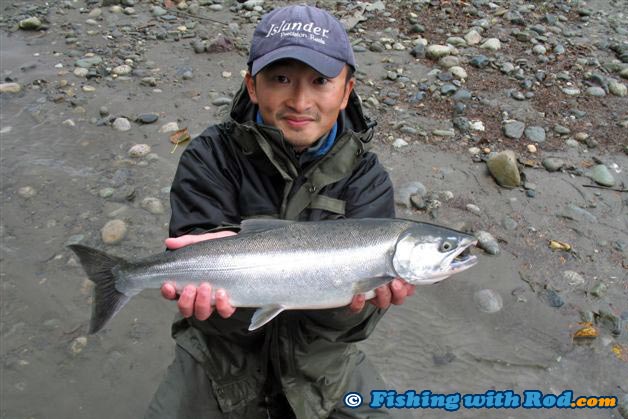
Each year, Chilliwack River's fall salmon fishery takes place between late August and early December. It is the most heavily used recreational fishing stream in British Columbia due to its short distance from Vancouver and successful hatchery program. This comprehensive guide is designed to assist those who are new to this fishery so they can have a chance to enjoy by learning the techniques, staying informed on regulations and etiquettes.
Fish Species & Regulations
All five species of Pacific salmon can be found in the Chilliwack River during this fishery but retention regulations of each species varies from year to year, depending on their return numbers. If you are unable to identify your salmon, then it is a good idea to release it to avoid accidentally killing a salmon that you are not allowed to keep.
The salmon regulations of Chilliwack River and daily quota of each salmon species can be found in Region 2 of Fisheries and Oceans Canada's Freshwater salmon supplement. It is really important that you check this prior to your trip just so you are familiar with what species you are allowed to keep.
You can only keep FOUR salmon in total per day, which means if you keep four hatchery coho salmon, you can't keep anymore chinook, pink or chum salmon.
| Species | Average size | Best fishing time |
|---|---|---|
| Chinook salmon | 5 - 30lb | early September - mid October |
| Coho salmon | 2 - 15lb | mid September - early November |
| Chum salmon | 5 - 15lb | early October - mid November |
| Pink salmon | 2 - 6lb | September |
| Sockeye salmon | 4 - 8lb | September |
Cultus Lake Sockeye Salmon Alert
Cultus Lake sockeye salmon are endangered and usually enter the Chilliwack River in late summer so their run time overlaps with other fall salmon species. All sockeye salmon caught in the Chilliwack River are required to be released carefully. Please be aware of the difference between a coho and a sockeye salmon. Some Cultus Lake sockeye salmon are also missing their adipose fin.
Salmon Identification
Because there are both species that you can keep and cannot keep returning to the Chilliwack River at the same time, it is important to know how to identify all five species of salmon.
Chinook salmon
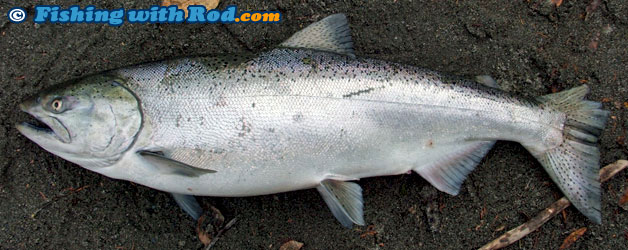
Chinook salmon have small spots across their back and small spots across their entire tail. Their gum is black and the edge of their jaw is white. Adult chinook salmon are defined as over 62cm and are required to be recorded on your licence when you choose to keep one.
Coho salmon
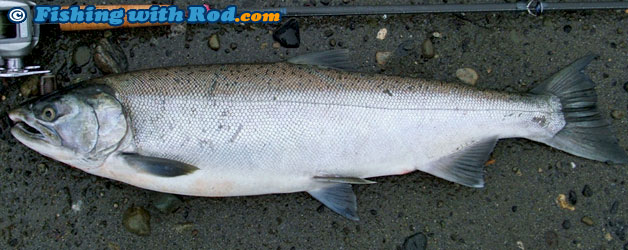
Coho salmon have small spots across their back and spots on the top portion of their tail. Their gum is white. Two groups of coho salmon are found in the Chilliwack River - Wild and hatchery marked fish. Hatchery marked fish, which anglers are allowed to keep, do not have an adipose fin. Instead, they have a healed scar where the adipose fin would be. This fin is clipped at the hatchery when they are at their juvenile stage prior to being released. If an adipose fin is present, then it is a wild fish, which is required to be released with care.
Chum salmon
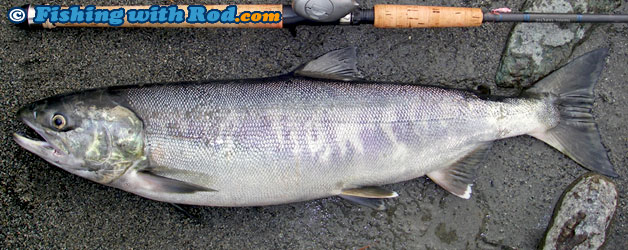
Chum salmon have two distinct characteristics, which are colourful (purple, pink, red, brown) stripes across their green/olive body and large teeth found on males.
Pink salmon
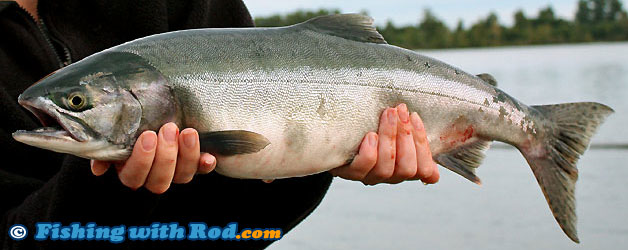
Pink salmon have large thumb-print type spots across their body and large spots across the entire tail. Males have a distinct humped back and their body colouration are typically dark green in the Chilliwack River once they enter the spawning phase.
Sockeye salmon
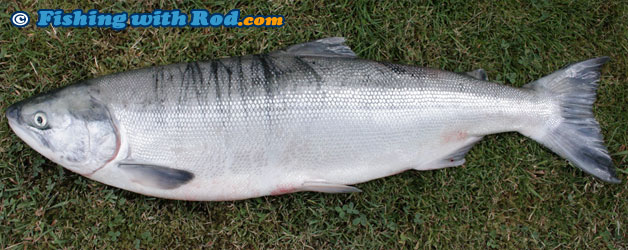
Althought sockeye salmon cannot be retained on the Chilliwack River, it is important to know what they look like so you do not kill one by accident. Sockeye salmon that are returning to Cultus Lake are endangered and their recovery depends on your assistance. Sockeye salmon are typically spotless and silver until they are near the spawning ground. At spawning stage, their body colouration is red while their head turns green. Some Cultus Lake sockeye salmon are hatchery marked, which means they also do not have an adipose fin like a hatchery marked coho salmon. It is important that you do not confuse the two and kill a sockeye salmon by accident.
Float Fish Effectively for Coho Salmon
To effectively catch salmon on the Vedder by float fishing, you want to keep your offerings in the strike zone. New anglers have a tendency to mistaken the strike zone as the depth where the fish are sitting. It is not. Salmonids look up and strike at the offerings just above them. The fish position themselves near the bottom, so the strike zone is usually 1 or 2 feet above the river bed. This technique does not only apply to the Chilliwack River, but also other Lower Fraser River tributaries.
| Rod: | 9' to 10'6" baitcasting or centerpin rod, rated between 8 and 20lb |
| Reel: | Small baitcasting reels or centerpin reels |
| Main line: | 12 to 15lb test |
| Leader: | 6 to 10lb test |
| Hook: | Size 4 to 2/0 |
The diagrams below illustrate the correct and not-so-correct ways of float depth adjustment.
Excessive length of leader
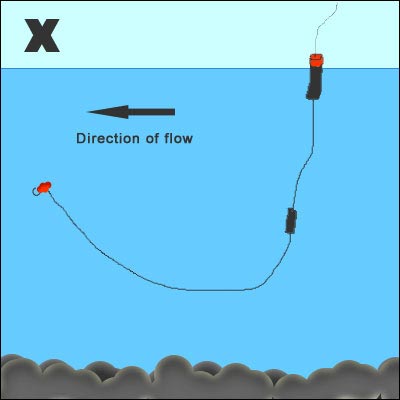
For some reason, many people believe a longer leader would produce more fish, quite the opposite! Your hook will always travel faster than your weight in a river. By using a long leader, your hook and bait are lifted up higher from the river bed, away from the strike zone.
Excessive float depth
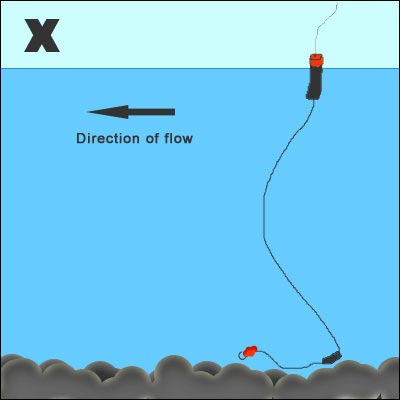
Some choose to adjust their float depth so the weight is "tapping" or sitting on the bottom. The weight will usually anchor itself to the river bed, while the float drifts slowly or becomes stationary. Two things will result from this setup:
- You'll snag onto the bottom, and lose your weight, hook and bait.
- Even worse, you'll end up snagging a pink or chinook in the belly or tail, which can be time consuming to bring in and release.
My way of float adjustment, but not necessarily the ONLY way
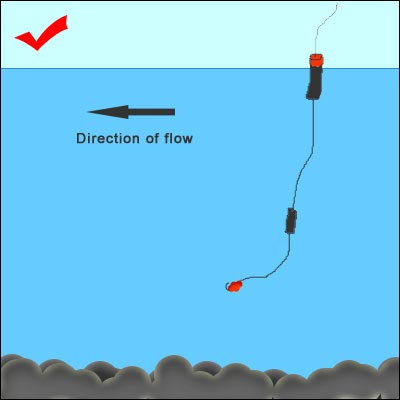
So far this has worked very well by producing about a dozen or more coho each season on the Chilliwack River without losing any hook, weight or line to snags. I usually like to keep my leader length (the line between the hook and weight) around 1.5 feet in length. Judging the depth by looking at the gradient of the river bank and the water, I adjust my float depth (the length from the float to the hook) so that it is about 1 to 2 feet shorter than the actual depth. When this is drifted, the bait will lift a few inches higher, remaining in the strike zone. When the float dips under the water, there is no hesitation as I don't need to question whether it is a snag or a fish. The hook is usually set hard and most of the time the fight is on.
Some other small adjustments
I find these adjustments would connect me into more fish in the past.
- The float size varies, small (11 grams) in clearer, slower water, while big (25 grams or more) in faster, deeper water.
- Tie on enough weight so only about 0.5 inch of your float (or the coloured tip) emerges on the water surface. This allows you to detect the bites sooner.
- Keep your main line (the line between your rod tip and your float) tight enough without disrupting the drift. Always try to avoid having any line laying on the water surface.
- Keep the drifts short. A longer drift doesn't necessarily mean a bigger chance to catch a fish. Long drifts also cause inconvenience for nearby anglers.
- Avoid standing in the water, especially when you arrive at a new location. Undisturbed fish have a tendency to stay close to the river bank.
Fishing Locations
The Chilliwack Vedder River is long. Some say it gets crowded, but the truth is only certain spots become congested. To have a good experience, it is best to avoid the busy spots. Busy spots are usually visible ones that can be accessed easily. These include Keith Wilson Bridge, railway bridge, Lickman Road, Peach Road, Vedder Crossing, Tamahi, Alison Pool. By going to a spot where less people are fishing, the likelihood of you hooking into some quality fish is bigger since the fish are not spooked. Surprisingly, you can usually find a nice quiet spot by taking a very short walk from one of these busy spots, even on weekends.

